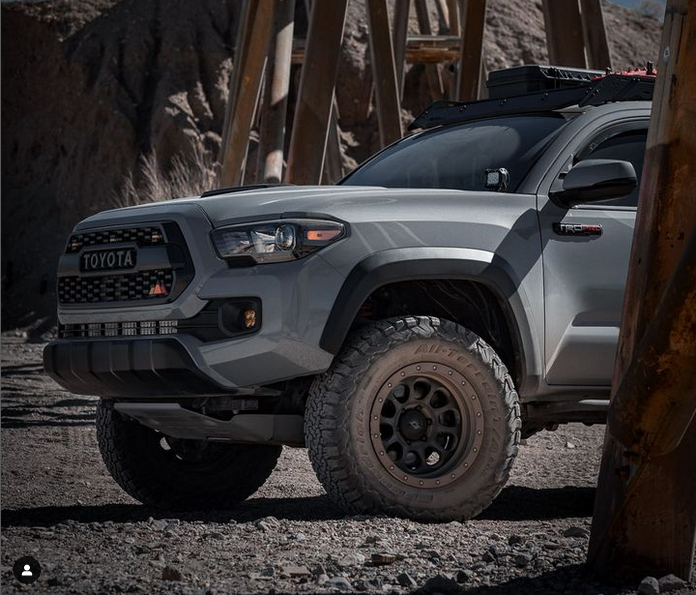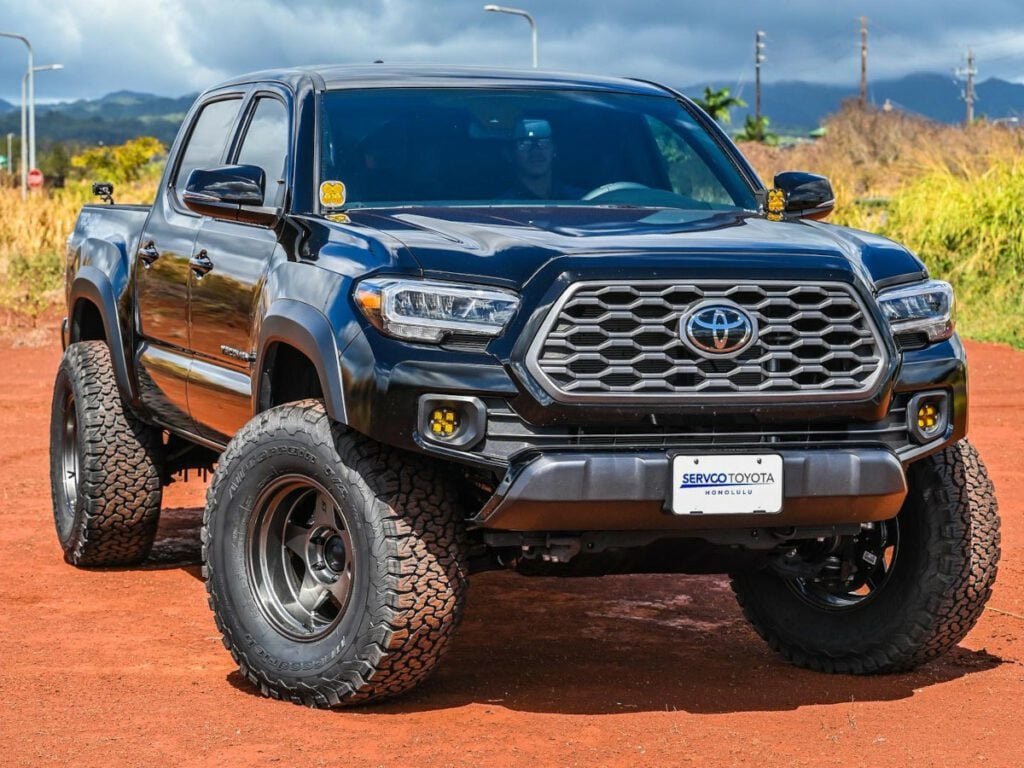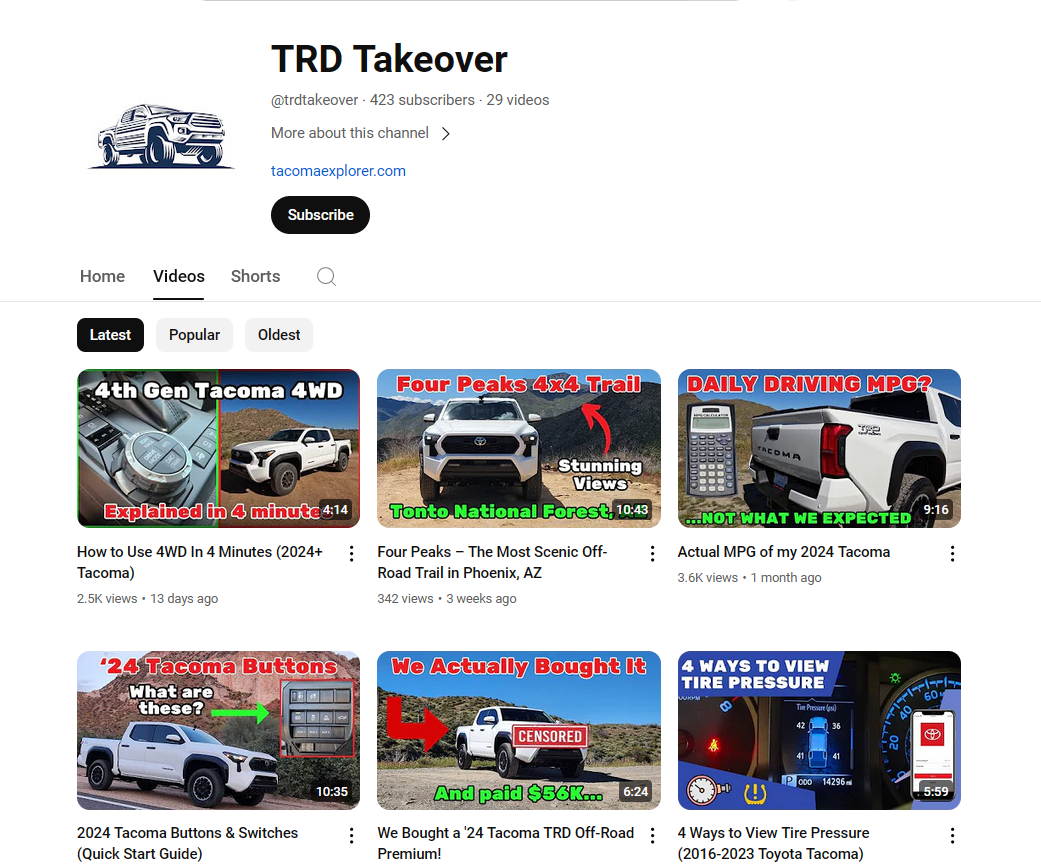Toyota Tacoma: Big Tires, No Lift
Big tires can offer improved off-road performance and an appealing aesthetic, but you can only go so large without lifting or cutting fenders.

Key Points:
- Larger tires offer several functional and aesthetic benefits.
- Adding tires that are too large, without a lift or cutting fenders, can result in rubbing.
- A viper cut is a great, low-cost option for increasing tire size capacity.
- Larger tires may have some negative effects on the driving experience.
In a perfect world, adding bigger tires to the Toyota Tacoma also means installing a lift. Yet, there are ways to put big tires on the Tacoma without a lift. Not only is this route cost-effective, but it also requires minimal effort.
In this guide, I walk you through the steps to picking big tires for the Toyota Tacoma and discuss the pros and cons of doing it without a lift. By the end of the article, you’ll know what’s right for your truck.
Introduction
As a Tacoma owner, you may desire to install larger tires but don’t want the hassle of adding a lift kit. There are several reasons for this, from needing to stick to a budget or if you aren’t sure that you’ll keep the truck long term, so there’s no reason to modify it.
As the driver of a Tacoma, you want the desired look and capability without making a large fuss. There’s no reason to deal with the complexities and costs of suspension modification just to add a larger tire.
This guide gives you the solution. I show you how to select a tire size for your Tacoma that won’t require a lift but gives you the upgrade you crave. There’s also a chance to use Viper Cuts to create some additional clearance.
The Appeal of Larger Tires
Here are several reasons you may want larger tires.
- Aesthetic appearance: Bigger tires look aggressive and stand out
- Functional purpose: Larger tires have better off-road performance, especially when traversing loose gravel, sand, mud, and dirt
- Increased traction: With a larger contact area, grip and stability are enhanced, especially while driving on slippery or rough terrain
- Improved cornering: With a stiffer sidewall and more contact area, handling and cornering improve
- Enhanced braking ability: Braking distance may be shortened with a larger contact area
Why to Avoid Lifting Your Tacoma
While you may be sold on the idea of adding larger tires, the thought of lifting the Tacoma may cause some apprehension. Thankfully, it’s not necessary to add a lift to the Tacoma to install bigger tires. The Tacoma comes with plenty of room in the wheel well for a bigger size.
Adding a lift means an additional cost you may not be ready for. It also means the possibility of suspension modifications unless you install a Tacoma spacer lift.
Pros and Cons
Here are a few considerations to think about when deciding whether to install larger tires without suspension mods.
Pros:
- Increased ground clearance
- Better on- and off-road handling/capability
- Enhanced aesthetic appeal
- Lower cost upgrade
Cons:
- Tire rubbing may occur without proper sizing
- Modifications, such as Viper Cuts, may be needed
- Fuel efficiency decreases
- Speedometer accuracy becomes a concern
- Ride comfort and noise may be negatively impacted
Determining the Right Tire Size
To choose the right tires for your Tacoma, it helps to begin by knowing the OEM size. This chart shows the recommended sizes for each Tacoma.
OEM Sizes
| 1995-2000 | 2001-2004 | 2005-2015 | 2016-2023 |
| 195/75R14 | 205/75R15 | 215/70R15 | 245/75R16 |
| 205/75R14 | 235/55R16 | 245/75R16 | 265/70R16 |
| 215/70R14 | 225/75R15 | 265/70R16 | 265/65R17 |
| 225/75R15 | 265/70R16 | 265/65R17 | 265/60R18 |
| 31X10.5R15 | 255/45R18 | ||
| 265/75R15 | 265/60R18 |
OEM tire sizes vary by trim level and equipment. Check the driver’s side door jamb for a placard that gives the correct specifications for your truck.
Large Sizes
To choose a bigger tire without modifications, you want to follow the 3% height and width rule. In general, the tire can be upsized at the height and width by 3% each without modifications. Therefore, you can get about 1 inch of height and .3 inches of width on most Tacomas.
For the 2nd and 3rd generation Tacoma, here are the largest tire sizes recommended without modifications.
- 16″: 265/75R16
- 17″: 265/70R17
- 18″: 265/65R18
Choosing an upgraded tire size will involve looking at the rim size and wheel well clearance.
Minor Modifications for Larger Tires

To accommodate larger tires, you may consider some minor modifications that make more room. Fender liner trimming is an option, but you must be careful with the process to ensure a sleek look. A Viper Cut is one option to increase tire clearance and the process is simple.
Here are some basic steps to follow.
- Mark the line to trim with masking tape. Match both sides.
- Cut the line with a rotary tool. Wear safety goggles for your protection.
- Use a heat gun to bend back the inner fender liner or cut it.
- Install automotive edge trim to make the area look professional.
You may also consider high-clearance fender liners to accommodate larger tires. These low-cost modifications make it easier to install the bigger tires you’ve had your eyes on.
Tire Selection: Types and Brands
Once you know how big you want to go, it’s time to consider the type and brand of the tires. For off-roading, you have the option between all-terrain or mud-terrain tires.
Mud-terrain tires (M/T) are 4×4 tires with a deep tread and aggressive design to keep the tire moving forward through deep mud. They also have reinforced sidewalls to prevent damage. However, these tires sacrifice road manners. The tread life won’t last as long, driving comfort decreases and you may go through more fuel.
All-terrain tires (A/T) are good for off-roading on gravel, dirt and sand. They have large block placements for better traction on slippery surfaces. Noise levels may increase over highway tires, but it’s far better than what’s heard with the mud-terrain tires. Yet, there are limitations with these tires, as they aren’t well-designed for deep mud or harsh conditions.
There’s also the issue of choosing the best tire brand for Tacomas. The 2023 Tacoma comes with Goodyear all-terrain tires, so you know this brand is a winner, or you could replace it with the BF Goodrich T/A KO2.
For highway travel, the Yokohama Geolandar H/T G056 is a good option.
The Installation Process
If you plan to install new tires and rims, the process is simple to perform at home. However, if you want to install new tires on the existing rims, it’s best to have a tire mounting machine. You also want to consider the weight of the tires and rims before you get started. Not everyone is capable of performing this job, and you should always consider safety first.
If you need to perform Viper Cuts, the steps for that are listed above. Beyond that, here are the equipment and steps to replace the tires.
Tools Needed
- Breaker bar
- Ratchet
- Sockets
- Floor jack
- Jack stands
- Impact gun (electric or pneumatic)
- Torque wrench
Directions
- While the truck is on the ground, loosen the lug nuts slightly.
- With the truck in Park and the emergency brake on, lift the first wheel off the ground.
- Unscrew the lug nuts and remove the wheel.
- Install the new wheel and tire, threading one lug at a time. Use the appropriate lug nut torque to secure the wheels.
- Gently lower the truck back down to the ground and repeat the process with the other wheels.
After the installation, you want to get alignment and wheel balancing performed to lengthen the tread’s life and ensure the best ride. You should also follow the recommendations in our Toyota Tacoma Wheel & Tire Maintenance Guide.
If there are any lights on the dash (ABS, traction control, etc) after the installation, have a professional mechanic take a look. You also should never ignore shaking, vibrations or other ride issues after a tire change.
(NAPA)
Impact on Vehicle Dynamics
After you install larger tires on your Tacoma, keep in mind that the driving experience may be different. It could take some time to get used to. Here are a few changes you may notice, depending on how much bigger the tires are.
- Ride becomes rougher
- Bumps may be felt easier
- Road noise may increase
- Braking time may decrease
- Cornering may be easier
It’s my recommendation to take the truck for a spin in a wide open area first. Play around with turning and stopping until you see how the truck responds to the change.
Maintenance and Care of Larger Tires
If you want the tires to last as long as possible, maintenance is critical. In our Toyota Tacoma Wheel & Tire Maintenance Guide, we give you some simple tips to help.
- Check tire pressure regularly
- Perform all maintenance at regular intervals, including alignment, balancing and rotations
- Replace worn suspension and steering parts at the first sign of trouble
- Store tires in a dry, cool location if you take them off for the winter
Take It To The Limit
If you drive a Tacoma, you’ve probably thought about how great it would be to install taller and wider tires on your truck. The improved traction and stability, better off-roading ability and aesthetic appeal make this a winning option. Yet, you may not want to spend a lot on suspension upgrades and a lift kit. That’s understandable.
It’s important to make an informed decision before choosing to install bigger tires without a lift. There can be serious consequences ranging from decreased fuel efficiency, a change to handling and damage to existing components.
It’s also critical that you choose the right tire for your truck, based on size and use. Don’t make this decision lightly and you’ll end up with a result that checks all the boxes.

